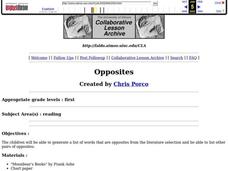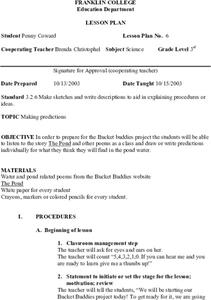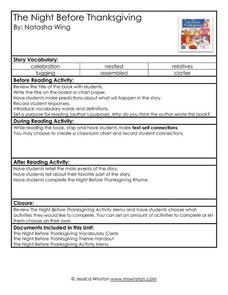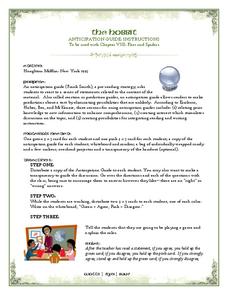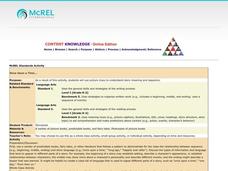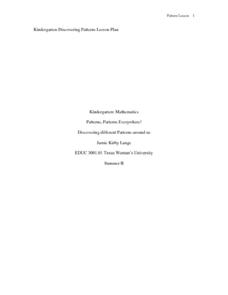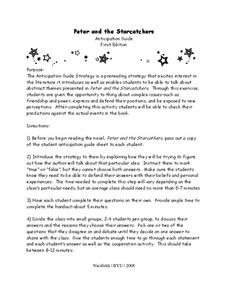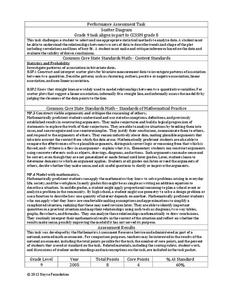Curated OER
Opposites
First graders take a picture walk through of the big book "Moonbear's Books" and make predictions on what they think is happening. Echo read to check predictions. Students generate words that are opposites on chart paper.
Curated OER
Making Predictions
Third graders develop predictions in preparation for a "Bucket Buddies" pond water project. They listen to the book "The Pond" and discuss the different life forms in the pond from the book. Students then read online poems, and draw a...
Curated OER
Just Another Lock on the Fence
Students make predictions regarding the subject of a news article, based on its title. They read the article and discuss it, answering various comprehension and thought questions.
Curated OER
Trouble with Trolls
Second graders read Trouble with Trolls. In this author/illustrator lesson, 2nd graders read a story and discuss their favorite parts. Students make predictions and connections to the book.
Curated OER
The Lady or the Tiger
Eighth graders make predictions on the topic of a story based on the title and the preview. After reading the story, they analyze what took place and create a graphic organizer explaining what they think would have happened had the...
Curated OER
Going Graph-y
Second graders listen to and dicuss the story Where the Wild Things Are. They play a pantomime game and act out various feelings so their classmates can guess. They listen for the frequency of certain words, and record their findings on...
Curated OER
The Night Before Thanksgiving
Natasha Wing's story The Night Before Thanksgiving is a great way to incorporate rhyme and literature into the Thanksgiving season. Learners make text-to-self connections, recall main events, and choose post-reading activities...
Novelinks
The Hobbit: Anticipation Guide
Prior to reading Tolkien's The Hobbit, class members respond to a series of statements in an anticipation guide that introduces many of the central concepts of the novel.
Curated OER
Once Upon a Time...
Model for emergent readers how to write a story by interpreting picture clues. For guided practice a second book is used, and then pupils work independently or with an adult to write their own stories based on illustrations.
Novelinks
Man's Search for Meaning: Anticipation Guide Instructions
To prepare readers for the major concepts in Victor Frankl's Man's Search for Meaning, an account of his life in Auschwitz, class members respond to a series of statements on an anticipation guide.
Curated OER
Water Cycle
Identify and interpret the earth's different water sources. Third and fourth graders describe and demonstrate the process of the water cycle, make a model of its two main parts, and predict and infer to answer questions about the...
Western Illinois University
Activities for Supporting Oral Language Development
Support young scholars' oral language development with the use of four early childhood activities. To reinforce proficiency, pupils read with an adult, play a game of telephone with their peers, put on a play with puppets or stuffed...
Reed Novel Studies
Tales of a Fourth Grade Nothing: Novel Study
Many turtle species can retreat their heads into their shells when threatened by predators. With the Tales of a Fourth Grade Nothing novel study, pupils conduct research to uncover other interesting turtle facts. As they explore Judy...
Texas Woman’s University
Patterns, Patterns Everywhere!
Not only is pattern recognition an essential skill for young children to develop, it's also a lot of fun to teach! Over the course of this lesson, class members participate in shared readings, perform small group...
Illustrative Mathematics
Walk-a-thon 2
During a walk-a-thon your learners must determine the walking rate of Julianna's progress. Using tables, graphs, and an equation, they must be able to calculate the time it took her to walk one mile and predict her distance based on the...
Curated OER
Peter and the Starcatchers: Anticipation Guide
Pique your pupils' interest before reading Peter and the Starcatchers with an anticipation guide. Given a list of 10 statements, learners choose true or false based on what they think the book is about. They then discuss in small...
Have Fun Teaching
Growing Seeds (9)
A seed, water, and sunlight. A seed, water, but no sunlight. A seed, sunlight, but no water. Young biologists are ask to infer what will happen to seeds given five different growing conditions.
Curated OER
ELD Lesson Plan: Courage
What is true courage? Your class can explore the answer with these three Houghton-Mifflin stories ("Hatchet," "Passage to Freedom," "Climb or Die," and "The True Confessions of Charlotte Doyle"), which feature courageous characters and...
Curated OER
Walk Two Moons: Hook and Concept of a Frame Story
As an introduction to Sharon Creexh's Walk Two Moons, a volunteer dons a pair of boots and walks about the classroom.Observers then ponder the axiom, Don't judge a man until you've walked two moons in his...
Novelinks
Running Out of Time: Anticipation Guide
Get your class ready to read with this anticipatory set for Running Out of Time. Small groups each consider one thought-provoking statement. After each group comes to a consensus, the whole class participates in sharing ideas and voting...
Inside Mathematics
Scatter Diagram
It is positive that how one performs on the first test relates to their performance on the second test. The three-question assessment has class members read and analyze a scatter plot of test scores. They must determine whether...
Curated OER
Ralph Ellison's Invisible Man: Anticipation Guide
A fan of anticipation guides? This resource not only offers directions on how to craft such a pre-reading activity, but also provides a model for Ralph Ellison's Invisible Man.
Curated OER
Recognizing Litter
When does trash become litter? Use this litter awareness lesson to help them understand the importance of trash disposal. Get learners engaged by reading Nancy Loewen's Lady Lulu Liked to Litter (not included). After discussing what...
Illustrative Mathematics
Walk-a-thon 1
Your mathematician's job is to explore the relationship between hours and miles walked during a walk-a-thon. The activity compels your learners to experiment with different means in finding out this proportional relationship. The answer...


